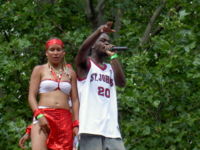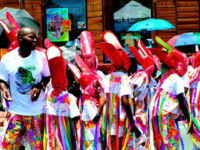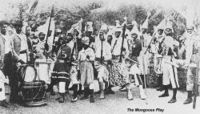Music of the Lesser Antilles
2007 Schools Wikipedia Selection. Related subjects: Musical genres, styles, eras and events
The music of the Lesser Antilles encompasses the musics of Martinique, Guadeloupe, Dominica, Trinidad and Tobago, Aruba and the Netherlands Antilles, Saint Vincent and the Grenadines, Anguilla, Antigua and Barbuda, Barbados, Grenada, Virgin Islands, Saint Lucia, Saint Kitts and Nevis and Montserrat. Lesser Antillean music is part of the broader category of Caribbean music; much of the folk and popular music is also a part of the Afro-American musical complex, being a mixture of African, European and indigenous American elements. The Lesser Antilles' musical cultures are largely based on the music of African slaves brought by European traders and colonizers. The African musical elements are a hybrid of instruments and styles from numerous West African tribes, while the European slaveholders added their own musics into the mix, as did immigrants from India. In many ways, the Lesser Antilles can be musically divided based on which nation colonized them.
The ex- British colonies include Trinidad and Tobago, whose calypso style is an especially potent part of the music of the other former British colonies, which also share traditions like the Big Drum dance. The French islands of Martinique and Guadeloupe, which share the popular zouk style and have also had extensive musical contact with the music of Haiti, itself once a French colony though not part of the Lesser Antilles. The Dutch colonies of Curaçao, Bonaire and Aruba, who share the combined rhythm popular style. The islands also share a passion for kaseko, a genre of Surinamese music; Suriname and its neighbors Guyana and French Guiana share folk and popular styles that are connected enough to the Antilles and other Caribbean islands that both countries are studied in the broader context of Antillean or Caribbean music.
Characteristics
While Lesser Antillean music is often discussed as a music area, this division is of limited usefulness. The islands of the Lesser Antilles divide musically along linguistic lines, with the most significant overlap coming from Dominica and Saint Lucia, both primarily Anglophone but strongly influenced by a French colonial past. Because the islands are divided linguistically, the term Antillean music is usually used in reference to one such music area. Thus, for example, the Rough Guide to World Music features a chapter on "Antillean music", which is entirely about the French Antillean islands of Martinique and Guadeloupe, with a brief sidebar specifically about the Dutch Antilles. In the context of Anglophone music, the term Antillean music most commonly refers to Trinidad and Tobago, home to the well-known calypso style. Music author Peter Manuel, for example, treats all the Anglophone islands as a subject of Trinidadian calypso traditions, while using the title Music of the Lesser Antilles for Francophone Antillean music. Manuel also, like many authors, treats Suriname and Guyana as integral aspects of Caribbean music; due to the Dutch colonial history of both countries, they are often grouped with Aruba and the Netherlands Antilles.
Nevertheless, Antillean music can be characterized by the prominence of the Carnival celebration, and the importance of calypso-like song traditions. The Lesser Antilles is also home to a strong Indo-Caribbean population; though Indo-Caribbean music is found elsewhere in the Caribbean, the prominence of Indian-influenced styles is a hallmark of the Antillean music scenes. Regional forms can also be found outside of the Caribbean entirely, most notably in New York City, where Brooklyn's Labor Day Carnival features music and parades, mas and steel bands; this Carnival is distinct to New York, and reflects elements of a pan-Caribbean nature.
Calypso and calypso-like traditions
Calypso is most closely associated with the island of Trinidad, but it has spread throughout the Lesser Antilles, and abroad. Similar traditions can be found natively on many of Caribbean islands. Within the Antilles, most of the popular calypso stars have come from Trinidad and Tobago; the majority of the exceptions, such as Arrow from Montserrat, have come from other Anglophone islands. Music author Peter Manuel has argued that, despite the modern Anglophone focus to calypso-like song forms, their origins lie in the "Afro-French creole culture", and notes that the ancestor of the word calypso, cariso, was first used to refer to a Martinican singer.
The calypso song complex is characterized by satirical, political, risque and humorous lyricism, a competitive and celebratory nature and its function in social organization and informal communication. Jamaican mento is perhaps the most well-known form of calypso-like music. The island of Carriacou is home to a calypso-like song style, as well as canboulay feasts, calinda songs and steel bands, all similar to though distinct from the related Trinidadian traditions. Modern influences from Trinidad have organized the Carriacou song style, and there are competitions similar to calypso tents on the island. The Antiguan benna is part of the same song complex, featuring news-oriented and ribald, often satirical lyrics and a rhythmic, uptempo style.
Carnival
Annual Carnival celebrations are an important part of the culture of all the Lesser Antillean islands. The Carnivals occur at varying times of year on each island, either pre-Lent, Christmastime or in July and August, and feature a wide variety of dances, songs and parades. Contests are common, especially Calypso King and Queen contests, which are held on most of the British Antillean islands, the U.S. Virgin Islands as well as French Saint-Martin and elsewhere. The British Antillean Carnivals are also mostly united by the J'ouvert tradition, which involves calypso and soca band parades and are the highlight of their celebrations.
Summer Carnivals include those on Antigua, Saint Vincent and the Grenadines, Sint Eustatius, Saint John, Saint Lucia, Grenada, Saba, Nevis and Anguilla, the latter two of which are especially known for popular calypso competitions. Christmastime Carnivals are held on Montserrat, Saint Croix, Saint-Martin and St. Kitts; Montserrat's distinctive Carnival includes masquerades and steelbands, and both islands also feature calypso competitions. The Carnival of Sint Maarten, which takes place a month after Easter, is known for the burning of King Moui-Moui as the culmination of the festival. Many islands, especially the French and Dutch Antilles, are home to pre-Lenten Carnivals, including Martinique, Aruba, Saint-Barthélemy, Bonaire, Curaçao, Dominica, Saint Thomas and Guadeloupe .
British Antilles
There are many popular traditions common to the English-speaking islands of the Lesser Antilles. Calypso, originally from the island of Trinidad, has spread to the neighboring islands; other Trinidadian popular traditions, like soca, are also well-known throughout the region. Steeldrum ensembles is also found throughout the English-speaking Lesser Antilles (and abroad), especially in Trinidad and Tobago and Antigua and Barbuda. The British Antilles also share in certain folk traditions. Trinidadian folk calypso is found throughout the area, as are African-Caribbean religious music styles like the Shango music of Trinidad. Variants of the Big Drum festival occur throughout the Windward Islands, especially in Saint Vincent and the Grenadines. Carnival is an important folk music celebration on all the islands of the Lesser Antilles, and the rest of the Caribbean.
Calypso is part of a spectrum of similar folk and popular Caribbean styles that spans benna and mento, but remains the most prominent genre of Lesser Antillean music. Calypso's roots are unclear, can be traced to 18th century Trinidad. Modern calypso, however, began in the 19th century, a fusion of disparate elements ranging from the masquerade song lavway, French Creole belair and the stick fighting chantwell. Calypso's early rise was closely connected with the adoption of Carnival by Trinidadian slaves, including camboulay drumming and the music masquerade processions. Popular calypso arose in the early 20th century, with the rise of internationally known calypsonians like Attila the Hun and Roaring Lion. Trinidadian calypso remained popular throughout the Caribbean in the later 20th century, and other Antillean islands, like Antigua began producing calypso stars. In the 1970s, a calypso variant called soca arose, characterized by a focus on dance rhythms rather than lyricism. Soca has since spread across the Caribbean and abroad.
Steel drums are a distinctively Trinidadian ensemble that evolved from improvised percussion instruments used in Carnival processions. By the late 1930s, bamboo tubes, a traditional instrumental, were supplemented by pieces of metal used percussively; over time, these metal percussion instruments were pitched to produce as many as twenty-some tones. Steel bands were large orchestras of these drums, and were banned by the British colonial authorities. Nevertheless, steeldrums spread across the Caribbean, and are now an entrenched part of Trinidadian culture.
Though Trinidadian popular music is by far the most well-known style of Lesser Antillean music, the other Anglophone islands are home to their own musical traditions. Carriacou and Grenada are home to Carnival celebrations that feature distinct form of calypso, canboulay feasts, calinda stick-fighting songs and the steelband accompanied jouvert, as well as the Big Drum dance, which is also found in Saint Vincent and the Grenadines. Grenada and Saint Vincent and the Grenadines share other musics as well including the funereal music of the saraca rite, a call-and-response form with both European and African lyrics.
French Antilles
French Creole music is most famously associated with Martinique and Guadeloupe, though the islands of Saint Lucia and Dominica are also home to French Antillean music. Creole music is characterized by the prominence of the quadrille dance, distinct from the French version and related to the Haitian mereng. The quadrille is a potent symbol of French Antillean culture Martinique and Guadeloupe are also home to their own distinct folk traditions, most influentially including Guadeloupan gwo ka and Martinican tambour and twi ba. Gwo ka is a type of percussion music which consists of seven basic rhythms and variations on them. It has been modernized into gwo ka moderne, though traditional rural performances ( lewoz) are still common. Tambour and twi ba ensembles are the origin of several important Martinican popular styles, including chouval bwa and biguine, and also exterted an influence on zouk. Lucian folk music features ensembles of fiddle, cuatro, banjo, guitar and chak-chak (a rattle), with the banjo and cuatro being of iconic importance, and recreational, often lyric song forms called jwé. The French Creole folk music of Dominica are based around the quadrille, accompaniedby ensembles called jing ping. Folk storytelling (kont) and songs (bélé) are also a major part of the country's musical identity.
Music authors Charles De Ledesma and Gene Scaramuzzo trace zouk's development to the Guadeloupan gwo ka and Martinican tambour and twi ba folk traditions. Ethnomusicologist Jocelyn Guilbault, however, describes zouk as a synthesis of Caribbean popular styles, especially cadence-lypso, biguine, kompa direk and kadans rampa. Zouk arose in the late 1970s and early 1980s, using elements of previous styles of Antillean music, as well as imported genres. In the 1950s, Haitian compas and cadence rampa became the dominant pop sounds of the Lesser Antilles, especially Webert Sicot and Nemours Jean Baptiste. These were followed by the Antillean mini-jazz bands like Les Gentlemen, Les Leopards and Les Vikings de Guadeloupe in the late 1970s, who drew on the Haitian sound of Sicot and Baptiste. Later in the decade and into the 1980s, the French Antilles became home to a style of cadence music called cadence-lypso. Gordon Henderson's Exile One innovated this style by adding calypso horns, and turned the mini-jazz combos into guitar-dominated big bands, paving the way for the success of large groups like Malavoi, among others. Drawing on these influences, the supergroup Kassav' invented zouk and popularized it with hit songs like "Zouk-La-Se Sel Medikaman Nou Ni". Kassav' formed from Paris in 1978. Kassav' soon added elements of rock and other influences and became some of the biggest stars in the Caribbean, France and elsewhere as zouk diversified into multiple subgenres. These include zouk-love, pop ballads by artists like Edith Lefel and Gilles Floro, and zouk funk and ragga-zouk bands like Lord Kossity who fused the genre with other influences.

Though zouk is the most well-known form of modern French Antillean music, the island of Martinique has also produced the chouval bwa and biguine styles, which were especally popular in the early 20th century. Chouval bwa is includes multiple distinctive instruments and internationally famous performers like Claude Germany, Dede Saint-Prix, Pakatak and Tumpak, while biguine has achieved international fame since the 1920s and has since been modernized and adapted for pop audiences, making it a major influence on zouk. Between the 1930s and 50s, the dance biguine was popular among the islands' dance orchestras. The biguine uses a cinquillo variant related to that found in other Caribbean genres like mereng and kompa direk. In the 1940s and 50s, these dance bands absorbed influences from Cuban, American and Haitian popular music.
Dutch Antilles
The islands of Curaçao, Bonaire, Aruba, St. Eustatius and St. Martin share musical styles, as well as maintain their own sets of folk and popular dances, ranging from the impromptu Statian road block to calypso, zouk and soca . African, indigenous and European ancestry predominate, though more recent immigrants have brought musics from Lebanon, China and India. In popular music, the islands are known for the Combined Rhythm, like local favorites the Happy Peanuts and Expresando Rimto i Ambiente. Kaseko music from the mainland country Suriname is also popular. Traditional music of Aruba and the Netherlands Antilles, however, is primarily African, characterized by the use of complex, highly developed polyrhythms, dance styles and drums like the tambú. Other African-derived instruments include metal percussion rods, agan, the rasp wiri, aerophones like the cachu trumpet, becu transverse double-reed wind instrument, and the bow benta.
The tambu is an instrument, and a form of music and dance found on Aruba, Bonaire (where it is sometimes known as bari), and Curaçao. The tambu is an especially important symbol of Curaçaoan identity. Instrumentation for the tambu uses the agan, triangle, wiri and other instruments, many of which are also part of the African-derived muziek di zumbi, or spirit music, of Curaçao. Curaçao's folk music also includes a rich tradition of work songs with apentatonic lyrics sung in Guene or a Papiamento variant called seshi. The Simadan harvest festival is found across the islands, and features the cachu trumpet, made from a cowhorn. Bonaire's Simadan festival is also notable for the use of the becu, an aerophone made from the stalk of a sorghum plant, and the kinkon, made from a conch shell and known elsewhere as the carco. Folk song forms range from the harvest seu, simadan and wapa. Other songs were imported beginning in the 19th century, including the South American joropo and pasillo, Spanish Caribbean merengue and other new songs, dances and instruments. This diverse mixture was the origin of the Dutch Antilles' most distinctive and long-standing popular tradition, the tumba.
The smaller islands of Saint Martin, Saba and St. Eustatius largely share in the same folk instruments, dances and songs as their neighbors; however, these islands remain largely unstudied. Saba is home to a vital percussive music tradition, most closely associated with private parties, using instrumentation similar to Curacau, Bonaire and Aruba. Saint Martin is home to a national dance form called the ponum, which dates to the 19th century and was only displaced by string bands in the mid-20th century. Saint Martin is also home to a calypso-like quimbe song form, that remains a major part of the island's culture.
Indo-Antillean
Indo-Caribbean people in the Lesser Antillean music area are clustered in Guyana, Suriname, and Trinidad and Tobago. Indo-Caribbean folk traditions include the chowtal songs from the springtime festival phagwa, and Hindi bhajans which are still sung at temples despite there being few people who understand Hindi. Guyanese and Trinidadian Indo-Caribbeans developed a tradition that fused elements of calypso with the folk music of North India, a style that was referred to as local music .
Indo-Caribbean music plays a vital role in various annual festivals like the springtime phagwa, where chowtal is traditionally performed competitively and in teams. Indo-Caribbean Shia Muslims celebrate Hosay ( Muharram) with floats accompanied by barrel drums called tassa. Wedding music is another important part of Indo-Caribbean music, and is dominated by tan singing. Tan singing is based around the dholak drum and dantal, and sometimes includes verbal duels influenced by picong. Indo-Caribbean popular music gained international attention in the late 1980s, with the rise of chutney music. Chutney is a dance music, in its modern form accompanied by soca instrumentation, such as synthesizers and pressure drums. This style is called chutney-soca.
- Babla and Kanchan's "Abu na Jaibe" —
- A chutney song by Babla and Kanchan

